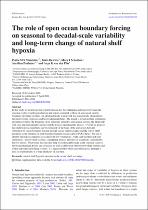 ResearchSpace
ResearchSpace
Role of open ocean boundary forcing on seasonal to decadal-scale variability and long-term change of natural shelf hypoxia
JavaScript is disabled for your browser. Some features of this site may not work without it.
- ResearchSpace
- →
- Research Publications/Outputs
- →
- Journal Articles
- →
- View Item
| dc.contributor.author |
Monteiro, Pedro MS

|
|
| dc.contributor.author |
Dewitte, B

|
|
| dc.contributor.author |
Scranton, MI

|
|
| dc.contributor.author |
Paulmier, A

|
|
| dc.contributor.author |
Van der Plas, AK

|
|
| dc.date.accessioned | 2012-01-09T12:31:07Z | |
| dc.date.available | 2012-01-09T12:31:07Z | |
| dc.date.issued | 2011 | |
| dc.identifier.citation | Monteiro, PMS, Dewitte, B et al. 2011. Role of open ocean boundary forcing on seasonal to decadal-scale variability and long-term change of natural shelf hypoxia. Environmental Research Letters, Vol 6(2), pp 18 | en_US |
| dc.identifier.issn | 1748-9326 | |
| dc.identifier.uri | http://iopscience.iop.org/1748-9326/6/2/025002/pdf/1748-9326_6_2_025002.pdf | |
| dc.identifier.uri | http://hdl.handle.net/10204/5454 | |
| dc.description | Copyright: 2011 Institute of Physics | en_US |
| dc.description.abstract | In this study the authors investigate the possible reasons for the widespread differences between the seasonal cycles of carbon production and export compared to those of hypoxia in eastern boundary upwelling systems. An idealized model is proposed that qualitatively characterizes the relative roles of physics and biogeochemical fluxes. The model is tested on three contrasting upwelling systems: the Benguela (from relatively aerated to interannual anoxic), the Humboldt (sub-oxic and interannually anoxic) and the Cariaco (permanently anoxic). Overall they propose that shelf hypoxia variability can be explained on the basis of the interaction between ventilation by ocean boundary forcing through ocean–shelf exchange and the role of shelf geometry in the retention of shelf-based particulate organic carbon (POC) fluxes. They aim to identify the hypoxia regimes associated with low ventilation—wide-shelf systems and high ventilation—narrow-shelf systems, considering them as extremes of conditions controlled by the two factors. They propose that this may help to explain differences in the seasonal cycles of the biogeochemical drivers and responses as well as difference between upwelling systems and within individual upwelling systems. It is suggested that when seasonal hypoxia emerges it does so preferentially at a wide-shelf part of a system. | en_US |
| dc.language.iso | en | en_US |
| dc.publisher | Institute of Physics | en_US |
| dc.relation.ispartofseries | Workflow request;7130 | |
| dc.subject | Natural shelf hypoxia | en_US |
| dc.subject | Carbon production | en_US |
| dc.subject | Benguela | en_US |
| dc.subject | Humboldt | en_US |
| dc.subject | Cariaco | en_US |
| dc.subject | Biogeochemical fluxes | en_US |
| dc.subject | Upwelling systems | en_US |
| dc.subject | Oceans | en_US |
| dc.title | Role of open ocean boundary forcing on seasonal to decadal-scale variability and long-term change of natural shelf hypoxia | en_US |
| dc.type | Article | en_US |
| dc.identifier.apacitation | Monteiro, P. M., Dewitte, B., Scranton, M., Paulmier, A., & Van der Plas, A. (2011). Role of open ocean boundary forcing on seasonal to decadal-scale variability and long-term change of natural shelf hypoxia. http://hdl.handle.net/10204/5454 | en_ZA |
| dc.identifier.chicagocitation | Monteiro, Pedro MS, B Dewitte, MI Scranton, A Paulmier, and AK Van der Plas "Role of open ocean boundary forcing on seasonal to decadal-scale variability and long-term change of natural shelf hypoxia." (2011) http://hdl.handle.net/10204/5454 | en_ZA |
| dc.identifier.vancouvercitation | Monteiro PM, Dewitte B, Scranton M, Paulmier A, Van der Plas A. Role of open ocean boundary forcing on seasonal to decadal-scale variability and long-term change of natural shelf hypoxia. 2011; http://hdl.handle.net/10204/5454. | en_ZA |
| dc.identifier.ris | TY - Article AU - Monteiro, Pedro MS AU - Dewitte, B AU - Scranton, MI AU - Paulmier, A AU - Van der Plas, AK AB - In this study the authors investigate the possible reasons for the widespread differences between the seasonal cycles of carbon production and export compared to those of hypoxia in eastern boundary upwelling systems. An idealized model is proposed that qualitatively characterizes the relative roles of physics and biogeochemical fluxes. The model is tested on three contrasting upwelling systems: the Benguela (from relatively aerated to interannual anoxic), the Humboldt (sub-oxic and interannually anoxic) and the Cariaco (permanently anoxic). Overall they propose that shelf hypoxia variability can be explained on the basis of the interaction between ventilation by ocean boundary forcing through ocean–shelf exchange and the role of shelf geometry in the retention of shelf-based particulate organic carbon (POC) fluxes. They aim to identify the hypoxia regimes associated with low ventilation—wide-shelf systems and high ventilation—narrow-shelf systems, considering them as extremes of conditions controlled by the two factors. They propose that this may help to explain differences in the seasonal cycles of the biogeochemical drivers and responses as well as difference between upwelling systems and within individual upwelling systems. It is suggested that when seasonal hypoxia emerges it does so preferentially at a wide-shelf part of a system. DA - 2011 DB - ResearchSpace DP - CSIR KW - Natural shelf hypoxia KW - Carbon production KW - Benguela KW - Humboldt KW - Cariaco KW - Biogeochemical fluxes KW - Upwelling systems KW - Oceans LK - https://researchspace.csir.co.za PY - 2011 SM - 1748-9326 T1 - Role of open ocean boundary forcing on seasonal to decadal-scale variability and long-term change of natural shelf hypoxia TI - Role of open ocean boundary forcing on seasonal to decadal-scale variability and long-term change of natural shelf hypoxia UR - http://hdl.handle.net/10204/5454 ER - | en_ZA |





